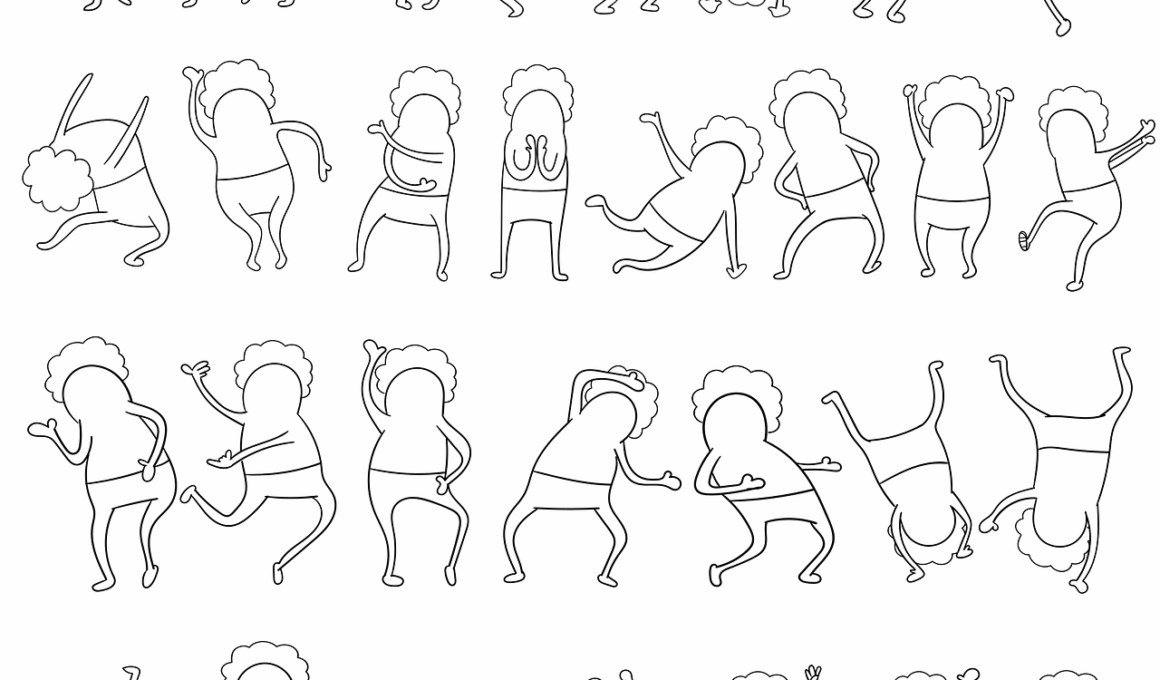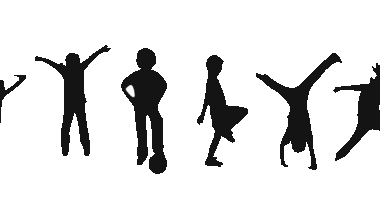How Group Dance Aerobics Challenges Promote Social Interaction
Group dance aerobics challenges are vibrant activities that blend fitness and socialization. These programs serve to improve participants’ physical health while simultaneously fostering social connections among participants. The structured environment of group classes encourages individuals to interact, support, and motivate each other, creating a community atmosphere. Such interactions break barriers and allow people to make new friends. Furthermore, the choreography requires synchronization, which enhances teamwork skills. Participants often feel more engaged when they face a challenge together, leading to increased camaraderie. As aerobic dance routines are both enjoyable and energetic, the laughter and shared enthusiasm contribute significantly to the development of social bonds. Regular engagement in these programs can also combat loneliness, especially among individuals who may find it hard to connect with others through traditional methods. The enjoyment derived from group challenges can keep individuals returning for more, solidifying both fitness habits and friendships. Meeting regularly for these sessions builds familiarity and trust, pivotal to meaningful relationships. Thus, group dance aerobics challenges are not just workouts but a comprehensive approach to fostering social interaction among diverse individuals.
Moreover, participation in dance aerobics challenges helps in developing communication skills. As individuals collaborate on dance routines, they naturally enhance their verbal and non-verbal communication abilities. This interaction encourages participants to express themselves, enhancing their comfort level within the group. Intrinsic to group dance is the sharing of ideas and feedback, as individuals support each other. Such exchanges foster a positive dialogue that spills over into other aspects of life. Regular attendance can slowly pull shy participants out of their shells, helping them open up. Furthermore, these classes often draw individuals from various age groups, backgrounds, and cultures. This diversity introduces participants to different perspectives, enhancing cultural understanding and tolerance. Witnessing and engaging with diverse attendees can lead to profound friendships that transcend age and cultural barriers. By embracing various styles, participants can learn new techniques and forms of expression, making their fitness journey dynamic and exciting. Notably, the sense of belonging formed during these classes builds self-esteem and confidence, vital components for both personal and social growth. Group dance aerobics thus becomes a conduit for communication and growth between individuals.
Boosting Team Spirit
Engaging in group dance aerobics challenges significantly boosts team spirit among participants. When individuals join forces to master a challenging routine, they instill motivation and support that enhance performance levels. This collaborative aspect nurtures an environment where everyone is focused on a common goal: success in the choreography. Participants learn that their individual contributions are essential to the group’s overall performance, reinforcing the importance of teamwork. As members encourage one another to improve and perfect their movements, bonds form between them, often leading to friendships outside the dance studio. This unique synergy establishes a strong sense of belonging and connection that benefits participants in their daily lives. The accountability generated by group practices can lead to better attendance, as members are motivated to show up not only for themselves but for their peers. This camaraderie can evolve into challenges beyond dance, as participants celebrate each other’s milestones, forming a closely-knit community. This shared journey toward fitness and accomplishment becomes not just physical exercise but a supportive social experience rich in learning, excitement, and growth toward common goals among participants.
Moreover, group dance aerobics challenges often include friendly competitions, further enhancing social interaction. These competitions can create a fun and motivating atmosphere where participants elevate their performance while building lasting connections. In preparing for such events, groups must communicate effectively, fostering deeper relationships as they work towards a common objective. Participants frequently find themselves collaborating to resolve challenges and perfect routines, leading to an organic strengthening of friendships. The excitement of competing together fosters shared experiences, creating cherished memories that enhance the bond between group members. Celebrating wins together, regardless of how small, cultivates a spirit of encouragement and enthusiasm that reverberates across the group. Participants often find that these shared experiences provide them with stories to tell and milestones to celebrate, transcending the dance floor. The friendly rivalry also brings out the best in individuals, who may thrive in high-energy environments surrounded by supportive peers. By intertwining these competitions, dance aerobics programs evolve into remarkable platforms for building lifetime friendships, bolstering participants’ social ties.
Improving Mental Health
Engaging in group dance aerobics challenges significantly improves participants’ mental health. Group fitness activities have been proven to release endorphins, leading to reduced stress and anxiety levels. The joy of movement combined with social interaction helps participants experience an emotional lift that is often elusive in solitary workouts. Moreover, expressing oneself through dance allows individuals to channel their emotions creatively, contributing positively to mental well-being. The energetic environment promotes self-expression and freedom, vital for alleviating feelings of depression and isolation. Additionally, as group members provide support and encouragement, individuals feel validated, enhancing their self-worth and confidence. These factors together create a strong psychological buffer against the day-to-day stresses many individuals face. Often, participants form deep connections based on shared experiences, which can act as a powerful tool in managing mental health challenges. Regular attendance not only creates a routine that contributes to physical fitness but fosters friendships and social networks that reinforce emotional support. These social bonds make it easier for participants to navigate challenges in their lives, knowing they have a community that genuinely cares for their well-being.
The inclusive nature of dance aerobics challenges also attracts individuals who may typically shy away from fitness environments. The supportive atmosphere encourages everyone to participate, regardless of their skill level. This welcoming vibe helps newcomers feel at ease, promoting lasting social interaction. Such inclusivity often leads to diverse groups where people can learn from one another’s experiences, broadening their perspectives. Additionally, participants often collaborate to help each other improve their dance techniques, fostering a sense of unity and belonging. As members see progress and celebrate each other’s successes, they cultivate an encouraging space that nurtures growth. This experience promotes teamwork and enhances personal achievements in a non-competitive environment. The friendships formed in these unique settings frequently extend outside the dance studio, resulting in social interactions that benefit personal lives as well. Such connections can lead to group outings, social events, and ongoing learning opportunities, demonstrating that group dance aerobics is not merely a fitness endeavor but also a path to forming genuine friendships. By encouraging inclusivity, these challenges promote social engagement by broadening individuals’ horizons.
The Long-Term Benefits
In conclusion, participating in group dance aerobics challenges yields long-term social benefits that extend beyond the dance floor. The relationships formed in these environments often blossom into friendships that last for years or even a lifetime. As individuals navigate their fitness journeys together, they create a strong support network that encourages not only persistence but also growth in personal lives. Such friendships offer a space where individuals can share life experiences, celebrate personal milestones, and navigate hardships together. Moreover, the design of these programs promotes regular attendance, fostering a sense of routine that reinforces social connectedness. As participants continue to engage in weekly classes, they remain physically active and build relationships that deepen over time. This consistent interaction cultivates a community that becomes integral to individuals’ lives, often leading them to undertake new challenges together both inside and outside of fitness settings. Group dance aerobics challenges embody a unique blend of fun and fitness while establishing lasting memories and connections among participants. Therefore, the significance of social interaction in these challenges cannot be understated, as it enriches participants’ lives in countless meaningful ways.
The vibrant atmosphere of group dance aerobics challenges offers an enriching experience that blends physical fitness with social interaction, vital for overall well-being. By emphasizing teamwork, communication, and inclusivity, these programs go beyond mere exercise and instill lasting bonds among participants. Such environments not only improve physical health but also cultivate emotional support networks that promote mental well-being. As friendships flourish and individuals thrive within these spaces, the impact of group dance aerobics extends far beyond the dance studio. The benefits gained from participating in these challenges serve as a powerful reminder of the profound influence of community and connection on our lives. Thus, individuals interested in joining a social fitness environment should consider immersing themselves in the world of dance aerobics challenges.


